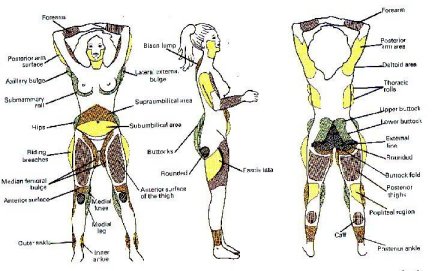Liposuction
Liposuction is the removal of fatty tissue from localised problem areas using a surgical technique. It is a fairly recent method of fat reduction that is proving to be very successful, and extremely popular. It helps both men and women to improve the contours of their bodies, through a remarkable and yet relatively simple and safe surgical procedure. The process involves the insertion of a slender, hollow metal tube or cannula, through a small incision, and by repeated movements, fat globules are separated and removed by vacuum suction through this tube. Incisions are small and are concealed in a skin fold near the site to be reduced, thus scars are virtually undetectable. Usually only one small incision is needed for each specific area. The area treated is injected with various solutions prior to insertion of the cannula, in order to reduce bleeding and to assist breakdown and loosening of the fat globules.
Liposuction while improving the silhouette does not necessarily eliminate the subtle puckering of the skin called cellulite. Cellulite results from the pull of fibrous tissue that connects skin to underlying muscle. What we do see is a reduction in the degree of cellulite because new techniques tend to sever the attached fibres allowing the skin to bounce up and return to a more smooth appearance. This is actually a "bonus" that one gets from the procedure but without any guarantee.
Liposuction sculpts or recontours the body and it must be stressed that the aim is to alter the patient's shape, rather than his or her overall weight. It is certainly effective in the removal of unwanted bulges and in improving the silhouette, but it is not a method for the treatment of general obesity. Fat cells removed by liposuction are permanently removed. Fat can never regenerate in the specific area thus treated. However, by eating to excess one may still gain excess weight and fatty bulges in other areas.

Particular areas of the body that can be helped by liposuction are the hips, inner thighs, outer thighs (" saddle-bags" or " riding-breeches" ), the abdomen or stomach, the buttocks, the waist (" love-handles" problem in men) upper arms, knees, ankles, the over-developed male breast, the "dowagers hump" problem, and the double chin. Liposuction may be carried out in a number of areas at the same time or be combined with another procedure. For example, it may be done with a facelift where excess fat is present under the chin. The amount of fat removed is up to the surgeon but between one and two litres is considered safe.
The operation may be carried out under general anaesthesia. Operation time will depend on the number and extent of areas treated. The length of stay in hospital will also vary for the same reasons, from a day case to one night.
 Pressure bandages or a corset will normally be applied immediately after surgery to control swelling and prevent any accumulation of blood or serum under the skin. We want to encourage the skin to attach snugly to the muscle wall. Bruising, swelling and discomfort after the operation is a normal but temporary condition, the degree depending upon the extent and location of the area treated. Pressure bandages or a corset will normally be applied immediately after surgery to control swelling and prevent any accumulation of blood or serum under the skin. We want to encourage the skin to attach snugly to the muscle wall. Bruising, swelling and discomfort after the operation is a normal but temporary condition, the degree depending upon the extent and location of the area treated.
Post-operative care instructions given by the surgeon must be followed carefully and will include massage to the area and the wearing of pressure bandages or a corset. The pressure bandages/corset will be removed at approximately five to seven days post-operatively, at stitch removal. Patients usually return to work after seven days, possibly before, although as mentioned, pressure bandages/corset will need to be worn under clothing for up to six weeks.
Suitability for this type of treatment, as with any other treatment, will be assessed by the surgeon at consultation, but is based on several factors, such as the quality and elasticity of the skin, the amount of fat requiring removal and the general condition of the patient and past medical history. The specifics are best discussed with the surgeon for a complete understanding of the potentials in any individual case.
There are, as always, with any type of surgery, the usual risks attached to the procedure, but these are fortunately limited and problems are rare. There is the risk of infection, that can be easily treated and for which we prepare for with antibiotics.. There generally will be some numbness in the area treated, most or all of which should disappear in six to eight weeks. Some waviness in the skin surface can occur but most people judge this a better situation than the existing fatty bulge and feel compensated by the resulting improvement in outline and silhouette and ability to wear slim, looser fitting clothes. The incision sites may also heal unfavourably. All of these are possible complications, but in reality are unlikely to arise if there is good elasticity of the skin and the amount of fatty tissue removed remains within safe limits.
Finally, fat removal by liposuction is one of the most exciting and effective treatments of modern cosmetic surgery. It is an excellent technique that produces very favourable results - it can also be judiciously employed with other procedures to enhance their effects. Again we must have realistic expectations and remember that the result is from good eating habits and exercise. Their relevancy can not be minimised. |